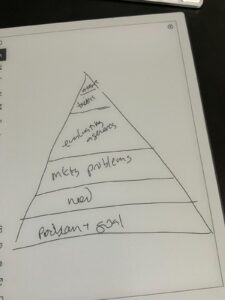Changing the Conversation, From the Beginning


I had a problem. Customers wanted training. They’d pay for training.
I knew they needed something else. It would take longer, require more work and money, but deliver a 5x greater likelihood of a positive outcome. Training would be part of it, but not till after we’d looked at their market, hiring, management, compensation and team structure.
You’re given the chance to sell something – anything – and the customer wants to buy THAT. But you know to really help them, they need to buy this other thing.
How do you do that? Read The Challenger Sale and try to pull it off with some tact?
Tell them they’re wrong? Convince them of your thesis? Put them through death-by-deck?
If you’re in a consultative sell, or selling professional services, or simply in a highly competitive space and need an advantage while the product works out some game-changer, read on.
This isn’t just my issue. I’ve worked with people in industries like accounting and fractional management who did something different but weren’t sure how to convey that to the prospect.
What were their options?
A great presentation designed to convince?
A killer Linkedin headline?
An amazing deck as part of that presentation?
An email nurture campaign that would sift through potential customers over 12 months?
They had real opportunities NOW and needed to convert those. (Sound familiar?)

Why does this matter?
What I’m about to share is a loose framework I learned in running sales calls or consults. It helped me do the following:
Give the prospect the feeling that I was talking about me or my company, which they expected
Cover the thing they wanted at the time – training
Differentiate from competitors by taking the conversation in a new direction. It would be one they chose from a series of options I gave them
Pivot the conversation to a bigger and more important discussion
It’s not rocket science. It is a different way of thinking.
Most people who haven’t worked with you want to hear something, just not everything. It’s an easy start to say, “We’ve never worked together. Would it make sense for me to share a little about us and how we think/operate?”
If I didn’t cover training – which they wanted – I’d be missing the boat. It could be done, but it’s not worth the fight, and besides, it was part of our offering. It just needed some context.
If you’re reading this, you’re likely in a competitive situation for clients, and sometimes you’re in line to meet with the prospect before or after someone else. It doesn’t hurt to look different. Those people come in, talk about themselves, their solution and present. Hard to stand out there.
I had to change the conversation if I wanted to help them the way they need AND get paid for it. And frankly, my experience is that people don’t value what they don’t pay for.

Tablestakes, or where you may want to start
What enabled me to do this was having a full cycle process for clients or customers, plus a series of categories for the concepts we implemented.
We were a “training” company, but we had to work on the aforementioned issues: hiring, management, messaging, comp, infrastructure, culture, etc… if training was going to work.
Ours process was taken from the strategy books of the 80s. We took the 7 S’s down to 4: strategy, structure, staff and skills.
If you don’t know your categories, there is plenty of literature out there to help you put a model around your thinking.
Let me give you the framework and then show you how I did it. I’ll then give a few examples for various industries.

The framework
This is actually pretty simple.
First – your categories
Think about the architecture of a company, problem, or individual’s situation that you touch. Put those into categories. Again, mine were strategy, structure, staff and skills. You don’t need alliteration to make this work. And when you get past 5, in my humble opinion, it’s too much for anyone to remember.
Second – the bullets
Then, under each one, write out areas of challenge they are likely to have. Don’t be shy here. Put down as many as you can think of.
Simple enough, right?
Third – sub-bullets
Under each challenge, write out how it’s likely to impact them, solutions they may have considered, and how they are probably thinking about the problem.
Fourth – ask
Turn each of those sub bullets into a conversational piece, often in the form of a question.
That’s the majority of the work.
Fifth – “where do you want to begin?”
This pivots the conversation to something more strategic, bigger than a basic product or solution, and out of the world of “you all look the same to me.”
Let me give you an example of how this sounded.
In reality
I’d start conversations with the usual stuff, and then move to, “Would it help for me to tell you a little about our company and how we work?”
Everyone said yes.
I then would do a little dog and pony about us, how long we’d been around, whom we worked with, and what we’re known for. The standard. That was my setup.
Then I’d pivot.
I drew a triangle (draw whatever you want) and say, “Here’s where training fits in this. It’s a ‘skills’ thing. It’s important. But I think about these other areas first: strategy, structure and staff. Then we get to skills. Let’s talk about these. Even if we don’t work together, you’ll get some ideas on how you may want to attack your challenge around _________.
Then I’d start with strategy.
I’d say, “Before we get into your team’s skills, we need to look at strategy and how you’re going to market so we don’t waste your time or money. Here are some of the things you’re probably thinking about with regard to strategy…You probably know your customer really well, but are wondering, ‘Do my people?’ You inherently know the problems of the customer, but you’re asking yourself, ‘How well does everyone get the problems of the ideal customer? Can they articulate them, or are they dependent on our product set to sell?’ Given what you know about your customer, my guess is feel good about how you’ve gone to market in the past, but you’re wondering, ‘What’s the next best channel for us to grow?’ ‘How are we positioned when we go to market? And how does that contrast with our competition? Can our prospects tell us apart from competitors when sales reps talk to them?’”
There are so many things you could touch on there, but those were some of how I touched on it.
We weren’t just talking about skills training anymore.
We’d move through structure – how they were put together, who reported to whom, how they motivated and held people accountable, comp structures and more.
Then we’d move into staff – roles, responsibilities, the people they had and their ability to fit into those roles and the strategy.
Skills came last and move us from talking about a “1 day refresh” to “Ok. This is a 6-12 month project on training alone.”
And most of this was phrased in the form of a question.
That was intentional.
The question got them thinking. I didn’t ask them the question. I said, “You’re probably thinking about this,” and so they would.
It’s not magic. It was just an inoffensive way to get an idea working. I needed to tell them how to think without sounding like a condescending jerk.
After I’d done this, I’d say, “Look, we can talk training, but this big picture is more important. Where do you want to begin?”
It was NEVER with training.
By the way, this took 5-10 minutes, not 30. So simmer down if you’re worried about time.
What it may look like for you
So what does this look like in other industries?
After 1 minute of thought, here’s how I’d probably attack it in various markets.
For accounting/finance work, I’d arrange it around:
books (table stakes),
reporting (understanding what’s going on),
cash flow projections (looking forward),
analysis (making better decisions)
and M&A (how to grow with acquisitions, leverage, or an exit strategy).
Maybe bookkeepers and accountants are doing this, but I doubt it. It also seems obvious. But there’s an escalation path for a business owner looking to hire out this work.
Other people charging $100 per hour won’t have that conversation. If they do, they won’t be charging $100 per hour for very long.
Another way to represent this might be on a spectrum:
In selling software, I’d take a flyer on talking about the following: standard business challenges; operational improvements; ROI expectations; usability; internal satisfaction; support. I’m not sold on this, but it’s where I’d start. It beats rushing to a demo and pushing them to a next step.
Not sure if a triangle is your best bet here….
Marketing. Oh marketing… Here’s how I’d attack this:
- What you probably experience seeking a marketing consultant/agency
Then…. - How to measure effectiveness
- Tactics
- How to evaluate a marketing agency/consultant
- How to think about marketing problems/goals
- Knowing what you actually need
- How to think about your own problems and goals
If you do this, is there any question that you 1) are different from competitors and 2) know what you’re talking about?
This will also uncover much deeper issues faster, while expanding scope and solving the real problems.
You’ll get out of commodity status quickly.
All the time?
This isn’t a fit for every role in every sale.
It’s great for consultants.
It’s great for those in commoditized services (law, accounting, real estate, insurance), or those trying to position service or thought leadership behind a product (SaaS).
For enterprise sales, it’s not a bad idea to put this framework in so you gain mindshare quickly.
Give this a shot. Let me know how it goes.
And if you want to pay a sizable sum to have me write it for you, I’ll entertain offers.







